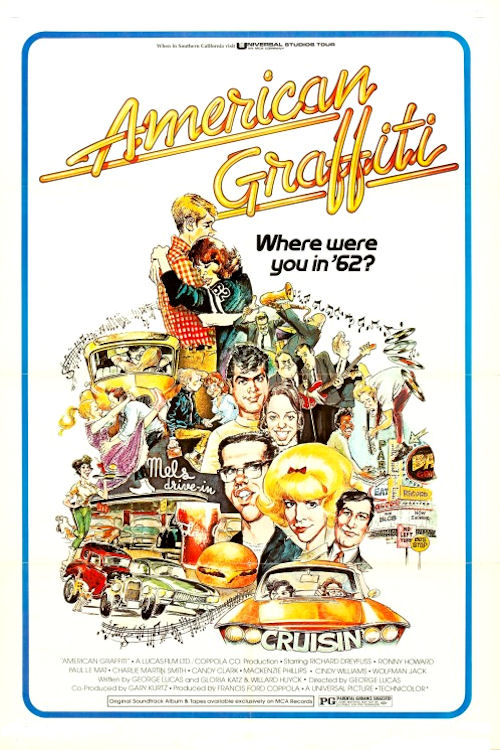Anthony's Film Review
American Graffiti (1973)

A movie that paints a nice picture of young American life...
American Graffiti, directed by George Lucas, is definitely an American film, giving us a broad and close-up glimpse into a specific demographic, time, and location in America. In this case, youngsters in a California town in the early 1960s during their last night before going off to college. This is one of those movies that deserves to be in a time capsule of American culture. If you were to collect American movies focusing on specific subcultures of America set in certain times and places, you would have a cinematic representation of American life across its history. American Graffiti would no doubt be a nice part of the set.
The first thing to note about this film is that there is no one plotline or character more important than the rest. All of the multiple plotlines and characters are equally important. Basically, think of American Graffiti as a painting, mural, or mosaic of a population of people, each doing their own unique thing. Or think of it as a collection of short stories that occur simultaneously and sometimes intersect, rather than a long novel. You also have these many characters appearing in just a few locations, including a diner, a high school dance, and the town's streets where characters engage in dialogue within their own vehicles or, more often, with people in other cars.
So who are these interesting characters and what do they do? Well, you have Ron Howard as Steve and Cindy Williams as his girlfriend Laurie, whose relationship is threatened because they'll be separated upon going to college. There's also Terry (played by Charles Martin Smith) who is nerdy, yet is able to score a date with the pretty dame Debbie (played by Candy Clark). Speaking of love, Richard Dreyfuss is Curt, a young man who is in love with a mysterious woman driving a white Thunderbird. And speaking of possibly strange love, John (played by Paul Le Mat) is a rough bad boy who gets stuck with Carol (Mackenzie Phillips), a bratty girl of about 13 years of age, essentially babysitting the girl when he didn't ask to do so. And if you want to throw in one more character, how about Harrison Ford as Bob Falfa, a cowboy hat-wearing enthusiast of street racing?
Even if the movie takes place over a single night in one specific city, a lot of interesting things can happen, like an attempt to obtain alcohol without ID, a prank on two officers in a police car, an encounter with members of a street gang, having a car stolen, and even a meeting with radio personality Wolfman Jack. Sometimes the moments on screen are just the littlest moments in life, like dialogue within and between adjacent cars moving down the street, but they are just as delightful. And yet, through it all, you want to know what happens next for the characters. The movie gives us multiple slices of life, and because life can be interesting, a movie simply about life can be entertaining, too.
The last thing I'll talk about is the director. George Lucas is mainly known for the massive franchise launched by his 1977 sci-fi classic Star Wars. But if you want to really see what he can do as a director, you'll want to look at his non-Star Wars movies, particularly the pre-1977 ones. American Graffiti is definitely one to check out, because it's something that I think anyone can connect to. It features real people in real moments in life (it's fiction, yes, but it still feels real). Lucas demonstrates a fine ability to capture American life and shows that he can leave a memorable mark not too long after graduating from film school. American Graffiti does deserve to be called an American classic, one that is simple yet delightful.
Anthony's Rating:










For more information about American Graffiti, visit the Internet Movie Database.
Home
Film Reviews
Other Reviews
Commentaries
Links
About AFR
RSS Feed
Privacy Policy
E-mail Anthony











